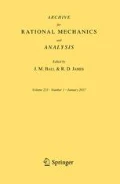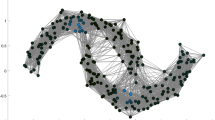Abstract
The classical Fokker–Planck equation is a linear parabolic equation which describes the time evolution of the probability distribution of a stochastic process defined on a Euclidean space. Corresponding to a stochastic process, there often exists a free energy functional which is defined on the space of probability distributions and is a linear combination of a potential and an entropy. In recent years, it has been shown that the Fokker–Planck equation is the gradient flow of the free energy functional defined on the Riemannian manifold of probability distributions whose inner product is generated by a 2-Wasserstein distance. In this paper, we consider analogous matters for a free energy functional or Markov process defined on a graph with a finite number of vertices and edges. If N ≧ 2 is the number of vertices of the graph, we show that the corresponding Fokker–Planck equation is a system of N nonlinear ordinary differential equations defined on a Riemannian manifold of probability distributions. However, in contrast to stochastic processes defined on Euclidean spaces, the situation is more subtle for discrete spaces. We have different choices for inner products on the space of probability distributions resulting in different Fokker–Planck equations for the same process. It is shown that there is a strong connection but there are also substantial discrepancies between the systems of ordinary differential equations and the classical Fokker–Planck equation on Euclidean spaces. Furthermore, both systems of ordinary differential equations are gradient flows for the same free energy functional defined on the Riemannian manifolds of probability distributions with different metrics. Some examples are also discussed.
Similar content being viewed by others
References
Ait-Haddou R., Herzog W.: Brownian ratchet models of molecular motors. Cell Bioch. Biophys. 38(2), 191–213 (2003)
Ambrosio, L., Gigli, N., Savaré, G.: Gradient Flows: in Metric Spaces and in the Space of Probability Measures. Birkhäuser, 2008
Astumian R.D.: Thermodynamics and kinetics of a Brownian motor. Science 276(5314), 917 (1997)
Bergmann P.G., Lebowitz J.L.: New approach to nonequilibrium processes. Phys. Rev. 99(2), 578 (1955)
Bonciocat A.I., Sturm K.T.: Mass transportation and rough curvature bounds for discrete spaces. J. Funct. Anal. 256(9), 2944–2966 (2009)
Buet C., Cordier S.: Numerical analysis of conservative and entropy schemes for the Fokker-Planck-Landau equation. SIAM J. Numerical Anal. 36, 953–973 (1999)
Carlen E.A., Gangbo W.: Constrained steepest descent in the 2-Wasserstein metric. Ann. Math. 157, 807–846 (2003)
Carlen E.A., Gangbo W.: Solution of a model boltzmann equation via steepest descent in the 2-Wasserstein metric. Arch. Rational Mech. Anal. 172(1), 21–64 (2004)
Chow S.N., Huang W., Li Y., Zhou H.: A free energy based mathematical study for molecular motors. Regular Chaotic Dyn. 16(1), 117–127 (2011)
Cordero-Erausquin, D., Gangbo, W., Houdré, C.: Inequalities for generalized entropy and optimal transportation. Recent Advances in the Theory and Applications of Mass Transport: Summer School on Mass Transportation Methods in Kinetic Theory and Hydrodynamics, September 4–9, 2000, Ponta Delgada, Azores, Portugal 353, 73 (2004)
Cordero-Erausquin D., McCann R.J., Schmuckenschläger M.: A Riemannian interpolation inequality à la Borell, Brascamp and Lieb. Invent. Math. 146(2), 219–257 (2001)
Van den Broeck, C.: The master equation and some applications in physics. Stoch. Process. Appl. Phys. 1–28 (1985)
Dobrushin R.L.: Prescribing a system of random variables by conditional distributions. Theory Probab. Appl. 15, 458 (1970)
Dolbeault, J., Kinderlehrer, D., Kowalczyk, M.: Remarks about the flashing rachet. Partial Differential Equations and Inverse Problems, 167–175. Contemp. Math., vol. 362
Ellis, R.S.: Entropy, Large Deviations, and Statistical Mechanics, vol. 271. Springer, 1985
Evans, L.C.: Entropy and Partial Differential Equations. Lecture Notes at UC Berkeley
Evans, L.C.: Partial differential equations and Monge-Kantorovich mass transfer. Current Developments in Mathematics, 65–126 (1997)
Evans, L.C., Gangbo, W.: Differential Equations ethods for the Monge-Kantorovich Mass Transfer-Problem, vol.137. American Mathematical Society, 1999
Gardiner, C.W.: Handbook of Stochastic Methods for Physics, Chemistry and Natural Sciences, 4th printing of the 2nd edn, 1997
Gilbarg, D., Trudinger, N.S.: Elliptic Partial Differential Equations of Second Order, 2001
Hao, G., Kim, W.H., Qian, H.: Thermodynamics and Geometry of Reversible and Irreversible Markov Processes. Preprint
Harmer G.P., Abbott D.: Game theory: losing strategies can win by Parrondo’s paradox. Nature 402(6764), 864–864 (1999)
Harmer G.P., Abbott D.: A review of Parrondos paradox. Fluct. Noise Lett. 2(2), R71–R107 (2002)
Heath D., Kinderlehrer D., Kowalczyk M.: Discrete and continuous ratchets: from coin toss to molecular motor. Discrete Contin. Dyn. Syst. B 2(2), 153–168 (2002)
Jordan R., Kinderlehrer D., Otto F.: Free energy and the Fokker-Planck equation. Physica D: Nonlinear Phenom. 107(2–4), 265–271 (1997)
Jordan R., Kinderlehrer D., Otto F.: The variational formulation of the Fokker-Planck equation. SIAM J. Math. Anal. 29(1), 1–17 (1998)
LeVeque, R.J.: Numerical Methods for Conservation Laws. Birkhäuser, 1992
Lott J.: Some geometric calculations on Wasserstein space. Commun. Math. Phys. 277(2), 423–437 (2008)
Lott J., Villani C.: Ricci curvature for metric-measure spaces via optimal transport. Ann. Math. 169, 903–991 (2009)
Mathews D.H., Turner D.H.: Prediction of rna secondary structure by free energy minimization. Curr. Opin. Struct. Biol. 16(3), 270–278 (2006)
McCann R.J.: Exact solutions to the transportation problem on the line. Proc. R. Soc. Lond. A: Math. Phys. Eng. Sci. 455(1984), 1341 (1999)
Mielke A.: A gradient structure for reaction–diffusion systems and for energy-drift-diffusion systems. Nonlinearity 24, 1329 (2011)
Otto F.: The geometry of dissipative evolution equations: the porous medium equation. Commun. Partial Differ. Equ. 26(1–2), 101–174 (2001)
Otto F., Villani C.: Generalization of an inequality by Talagrand and links with the logarithmic Sobolev inequality. J. Funct. Anal. 173(2), 361–400 (2000)
Otto F., Westdickenberg M.: Eulerian calculus for the contraction in the Wasserstein distance. SIAM J. Math. Anal. 37(4), 1227–1255 (2005)
Percus O.E., Percus J.K.: two wrongs make a right? Coin-tossing games and Parrondos paradox. Math. Intell. 24(3), 68–72 (2002)
Qian H.: Motor protein with nonequilibrium potential: its thermodynamics and efficiency. Phys. Rev. E 69(1), 012901 (2004)
Qian H.: Cycle kinetics, steady state thermodynamics and motors—a paradigm for living matter physics. J. Phys. Condens. Matter 17, S3783 (2005)
Qian M., Zhang X., Wilson R.J., Feng J.: Efficiency of Brownian motors in terms of entropy production rate. Europhys. Lett. 84, 10014 (2008)
Risken, H.: The Fokker-Planck Equation: Methods of Solution and Applications, vol. 18. Springer, 1996
Sammer M., Tetali P.: Concentration on the discrete torus using transportation. Combin. Probab. Comput. 18(5), 835–860 (2009)
Schuss, Z.: Singular perturbation methods in stochastic differential equations of mathematical physics. SIAM Rev. 22, 119–155 (1980)
Smolka, B., Wojciechowski, K.: Contrast enhancement of badly illuminated images based on Gibbs distribution and random walk model. CAIP’1997, 271–278, 1997
Sturm K.T.: Generalized Ricci bounds and convergence of metric measure spaces. Comptes Rendus Math. 340(3), 235–238 (2005)
Sturm K.T.: On the geometry of metric measure spaces . Acta Math. 196(1), 65–131 (2006)
Sturm K.T.: On the geometry of metric measure spaces, II. Acta Math. 196(1), 133–177 (2006)
Vaserstein L.N.: Markov processes over denumerable products of spaces, describing large systems of automata. Problemy Peredachi Informatsii 5(3), 64–72 (1969)
Villani, C.: Topics in Optimal Transportation, vol. 58. American Mathematical Society, 2003
Villani, C.: Optimal Transport: Old and New, vol. 338. Springer, 2009
Von Renesse M.K., Sturm K.T.: Transport inequalities, gradient estimates, entropy and Ricci curvature. Commun. Pure Appl. Math. 58(7), 923–940 (2005)
Von Renesse M.K., Sturm K.T.: Entropic measure and Wasserstein diffusion. Ann. Probab. 37(3), 1114–1191 (2009)
Wu, Y., Hua, G., Yu, T.: Tracking articulated body by dynamic Markov network. Proceedings of Ninth IEEE International Conference on Computer Vision, 2003. IEEE, 1094–1101, 2003
Author information
Authors and Affiliations
Corresponding author
Additional information
Communicated by D. Kinderlehrer
Rights and permissions
About this article
Cite this article
Chow, SN., Huang, W., Li, Y. et al. Fokker–Planck Equations for a Free Energy Functional or Markov Process on a Graph. Arch Rational Mech Anal 203, 969–1008 (2012). https://doi.org/10.1007/s00205-011-0471-6
Received:
Accepted:
Published:
Issue Date:
DOI: https://doi.org/10.1007/s00205-011-0471-6




